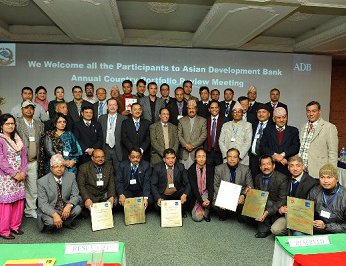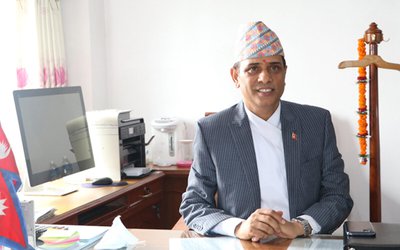
As Nepal has been passing through a prolonged political instability, it has affected Nepal’s overall capital spending. With just over 10 percent of capital spending in the last six months, the development process of Nepal, which is aspiring to graduate from the status of LDC to that of a developing country, is sluggish.
Along with the total capital spending, the disbursement ratio of foreign supported program is also dismal. A recently concluded 2-day Country Portfolio Meeting of Asian Development Bank discussed the ways to clear the hurdles to increase the disbursement ratio in Nepal.
Low capital spending means low job creation and low economic growth. In this context, Nepal needs to enhance its capacity in capital spending. “The government is serious about the present situation and is making all efforts to increase the present capital spending. We have made certain progress in the last six months in this regard,” said Finance Secretary Suman Kumar Sharma.
ADB too holds the view that Nepal has little option other than to increase the present rate of capital spending. “In order to accelerate the economic growth and job, Nepal needs to address the huge infrastructure gap, by subsequently increasing infrastructure investments from the present level of just about 4 percent of GDP to 8-12 percent of GDP,” said Diwesh N. Sharan, deputy Director General, South Asia Department, ADB.
Nepal has made good progress in the last six months in capital spending including ADB’s disbursement ratio. Given the growing political instability following the recent political development, there are challenges to maintain it.
"Nepal’s capital spending is still not up to the mark. Obviously, this is reflected in ADB portfolio as well. At the end of 2014, Nepal’s ongoing portfolio is almost $ 1.8 billion. However, as much as 50 percent of the portfolio is yet to be contracted and 69 percent are undisbursed. The contract award of $210.9 million without programs with contract award ratio of 23.2 percent, the disbursement was 151.4 million, including programs with disbursement ratio of 12.8 percent and $124.4 million without programs with disbursement ratio of 11.1 percent. Though the achievement figures are not ideal but they are historically highest for Nepal's country operation. This is a positive sign,” said Sharan.
Following the last elections and formation of the government, Nepal’s overall situation has improved. Although Procurement Act, legal provisions and frequent interventions by anti-graft body and court creates hurdles to development projects, ADB has made some good progress.
"Please let me start by recalling the discussion of the last CPRM in the late 2013, where we informed that Nepal’s portfolio performance deteriorated to the ratio of 3.0 (Out of 5.0) in FY 2013. In light of ADB’s performance based ADF allocation policy, we informed that the ADF allocation may be substantially reduced from the 2013-2014 level $ 237 million per year. However, I am glad to inform that the performance rating was 4.5 percent in FY 2014/015 biannual period. Thus, I would first like to thank the efforts made by all project agencies and ADB staff to pursue higher portfolio rating,” said Kenichi Yokoyama, country director, ADB Resident Mission. “I must say that this improved agencies and ADB staff to pursue higher portfolio rating. Nevertheless, I must say that this improved rating is achieved mostly by a series of short-term measures to avoid 'at risk' ratings for individual project, and fundamental constraints hampering sustained high portfolio rating still remains.”
If Nepal wants to accelerate economic growth, Nepal needs to increase its present rate of capital spending and capital disbursement. However, it is easy to say than do things given the present state of Nepal.
“The government is taking all necessary steps to overcome the hurdle to increase the capital spending. We want to invest more money in infrastructure like roads and power projects,” said Finance Secretary Sharma.
Nepal’s challenges are still on to increase portfolio performance with ABD supported projects. “As of December 2014, ADB’s active project portfolio amounts to $ 1.59 bilion with 35 investments projects in six sectors. Out of this, about $0.85 billion (53 percent) is still to be awarded and $1.2 billion (73 percent) is still to be disbursed, which are very high. This should be reduced to 40 percent and 60 percent respectively. They account for 23 percent and 11 percent of the uncommitted and disbursed funds, which should ideally be about 25 percent. These annual achieved amounts are historical records for Nepal and contract award figures may look reasonable. However, low disbursement ratio remains and major concern for the country’s portfolio,” said Kenichi Yokoyama ADB country director.
The two days' CPRM concluded covering the systematic, sector specific and project specific problems. The participants also discussed the way to address the issues surfaced in the various projects.
One of the major reasons behind the slow progress in ADB’s project is complicated procedural issues of Nepal. There are so many complexities in the process of implementation.
Although it is finally settled, Tanahu Hydro Electric Project is going to be delayed for another year adding cost due to hurdles surfaced in the process of signing the agreement with Consultants.
“Many projects face slow progress of awarded contract, due to low performance of contractors and consultants and insufficient management of the project agencies. Weakness in Contract management such as weak enforcement of contractual provision has been noted as fundamental constraints in many infrastructure projects in energy, transport, urban infrastructure, rural roads and irrigation sectors,” said Kenichi Yokoyama, ADB’s country director.
As Nepal is passing through a severe political transition, the progress achieved by projects and programs funded by the Asian Development Bank is up to mark. As a largest multilateral development partner of Nepal, ADB’s support to Nepal in infrastructure project is very important. Thus, the progress matters much.
- TANAHU HYDROPOWER PROEJCT: A Significant Achievement
- Apr 15, 2024
- AMBASSADOR HANAN GODAR: Sharing Pain With A Nepali Family
- Mar 30, 2024
- VISIT OF KfW AND EIB TO NEPAL : Mission Matters
- Mar 25, 2024
- NEPAL BRITAIN SOCIETY: Pratima Pande's Leadership
- Mar 24, 2024
- NEPAL ARMY DAY: Time To Recall Glory
- Mar 15, 2024
















